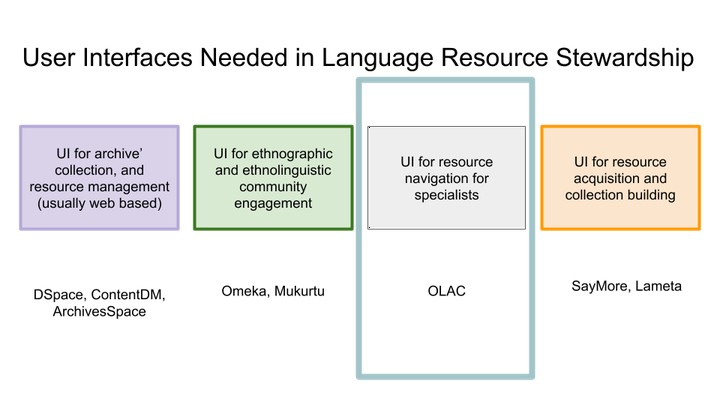A Vision for New Participation in OLAC: Beyond an Agenda for Open Language Archiving

Abstract
Bird and Simons (2021) state that “new investment is required in order to move OLAC into the digital libraries mainstream”. We lay out some specific social and technical challenges before the OLAC community which affect the future participation of data providers and their audiences. We situate OLAC as a mission partner to accomplish the goals of data providers in their service to the scholarly community. In contrast to Bird and Simons’ discussion of significant network traffic, we find that OLAC search results are often buried. We discuss two technical advances that would serve to amplify OLAC pages, and in turn language archive holdings.
Bird and Simons further suggest that understanding niche sub-communities is key to future success; however, they stop short of analyzing the sub-communities who have already identified value gained from participating in OLAC. We present an analysis that divides OLAC data providers into types, rather than considering them all “archives”, and uses a gap analysis to map the community’s growth opportunities.
Significant among un-/under-engaged data providers are traditional libraries, research libraries, and publishers. Some libraries refrain from participating in OLAC citing fear of breaching metadata sharing contracts with OCLC, and yet large sets of open access MARC records from other libraries remain unassessed for language resources. Publishers remain unengaged for a variety of reasons, but a frequent one is that open source software solutions do not have modules for implementing OLAC data feeds.
Finally, we explore normalization methods that the digital libraries community has developed to craft more user-friendly engagement with cross-institutional aggregations of metadata (Lynch, et al. 2020). We make suggestions on how metadata quality assessment and normalization of data can work together to improve the OLAC user experience. Initial estimations show a three-fold increase is possible for both language resource coverage and user engagement.
Bibliography
- Lynch, Gibson & Han (2020)
- Lynch, J., Gibson, J. & Han, M. (2020). Analyzing and Normalizing Type Metadata for a Large Aggregated Digital Library. The Code4Lib Journal, 47. Retrieved from https://journal.code4lib.org/articles/14995
- Bird & Simons (2021)
- Bird, S. & Simons, G. (2021). Towards an Agenda for Open Language Archiving. University of North Texas. https://doi.org/10.12794/langarc1851171
Categories:
Content Mediums: